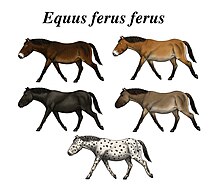
Back Genètica de pelatges dels cavalls Catalan Genetik der Pferdefarben German Genética de los pelajes del caballo Spanish Наследование мастей и отметин лошадей Russian

Equine coat color genetics determine a horse's coat color. Many colors are possible, but all variations are produced by changes in only a few genes. Bay is the most common color of horse,[2] followed by black and chestnut. A change at the agouti locus is capable of turning bay to black, while a mutation at the extension locus can turn bay or black to chestnut.
These three "base" colors can be affected by any number of dilution genes and patterning genes. The dilution genes include the wildtype dun gene, believed to be one of the oldest colors extant in horses and donkeys. The dun gene lightens some areas of the horse's coat, while leaving a darker dorsal stripe, mane, tail, face, and legs. Depending on whether it acts on a bay, black, or chestnut base coat, the dun gene produces the colors known as bay dun, grullo, and red dun.
Another common dilution gene is the cream gene, responsible for palomino, buckskin, and cremello horses. Less common dilutions include pearl, champagne, and silver dapple. Some of these genes also lighten eye color.
Genes that affect the distribution of melanocytes create patterns of white spotting or speckling, such as in roan, pinto, leopard, white or white spotting, and even some white markings. Finally, the gray gene causes depigmentation of the hair shaft, slowly adding white hairs over the course of several years until the horse's body hair is near or completely white.
Some of these patterns have complex interactions. For example, a single horse may carry both dilution and white patterning genes, or carry genes for more than one spotting pattern. Horses with a gray gene can be born any color and their hair coat will lighten and change with age.
Most wild equids are dun, as were many horses and asses before domestication of the horse. Some were non-dun with primitive markings, and non-dun 1 is one of the oldest coat color mutations, and has been found in remains from 42,700 years ago, along with dun. Non-dun 2, the version of the dun gene that most domestic horses have, is thought to be much more recent, possibly from after domestication.[3] Leopard complex patterns also predate domestication, having been found in horse remains from 20,000 years ago. The mutation responsible for black and grullo also predates domestication.[1] The mutations causing chestnut, sabino 1, and tobiano appeared shortly after horse domestication, roughly 5000 years ago.[4] Silver and cream dilutions appeared at least 2,600 years ago, and pearl appeared at least 1400 years ago.[5] The gray mutation is also post-domestication but thought to be thousands of years old as well.[6]
- ^ a b Pruvost, Melanie; Bellone, Rebecca; Benecke, Norbert; Sandoval-Castellanos, Edson; Cieslak, Michael; Kuznetsova, Tatyana; Morales-Muñiz, Arturo; O'Connor, Terry; Reissmann, Monika; Hofreiter, Michael; Ludwig, Arne (15 November 2011). "Genotypes of predomestic horses match phenotypes painted in Paleolithic works of cave art". Proceedings of the National Academy of Sciences. 108 (46): 18626–18630. Bibcode:2011PNAS..10818626P. doi:10.1073/pnas.1108982108. PMC 3219153. PMID 22065780.
- ^ Cite error: The named reference
SponenbergBellone2017was invoked but never defined (see the help page). - ^ Imsland, Freyja; McGowan, Kelly; Rubin, Carl-Johan; Henegar, Corneliu; Sundström, Elisabeth; Berglund, Jonas; Schwochow, Doreen; Gustafson, Ulla; Imsland, Páll; Lindblad-Toh, Kerstin; Lindgren, Gabriella; Mikko, Sofia; Millon, Lee; Wade, Claire; Schubert, Mikkel; Orlando, Ludovic; Penedo, Maria Cecilia T; Barsh, Gregory S; Andersson, Leif (February 2016). "Regulatory mutations in TBX3 disrupt asymmetric hair pigmentation that underlies Dun camouflage color in horses". Nature Genetics. 48 (2): 152–158. doi:10.1038/ng.3475. PMC 4731265. PMID 26691985.
- "A horse of a different color: Genetics of camouflage and the dun pattern". ScienceDaily (Press release). December 21, 2015.
- ^ Ludwig, Arne; Pruvost, Melanie; Reissmann, Monika; Benecke, Norbert; Brockmann, Gudrun A.; Castaños, Pedro; Cieslak, Michael; Lippold, Sebastian; Llorente, Laura; Malaspinas, Anna-Sapfo; Stalkin, Montgomery; Hofreiter, Michael (2009). "Coat Color Variation at the Beginning of Horse Domestication". Science. 324 (5926): 485. Bibcode:2009Sci...324..485L. doi:10.1126/science.1172750. PMC 5102060. PMID 19390039.
- ^ Wutke, Saskia; Benecke, Norbert; Sandoval-Castellanos, Edson; Döhle, Hans-Jürgen; Friederich, Susanne; Gonzalez, Javier; Hallsson, Jón Hallsteinn; Hofreiter, Michael; Lõugas, Lembi; Magnell, Ola; Morales-Muniz, Arturo; Orlando, Ludovic; Pálsdóttir, Albína Hulda; Reissmann, Monika; Ruttkay, Matej; Trinks, Alexandra; Ludwig, Arne (23 December 2016). "Spotted phenotypes in horses lost attractiveness in the Middle Ages". Scientific Reports. 6 (1): 38548. Bibcode:2016NatSR...638548W. doi:10.1038/srep38548. PMC 5141471. PMID 27924839.
- ^ Rosengren Pielberg, Gerli; Golovko, Anna; Sundström, Elisabeth; Curik, Ino; Lennartsson, Johan; Seltenhammer, Monika H; Druml, Thomas; Binns, Matthew; Fitzsimmons, Carolyn; Lindgren, Gabriella; Sandberg, Kaj; Baumung, Roswitha; Vetterlein, Monika; Strömberg, Sara; Grabherr, Manfred; Wade, Claire; Lindblad-Toh, Kerstin; Pontén, Fredrik; Heldin, Carl-Henrik; Sölkner, Johann; Andersson, Leif (August 2008). "A cis-acting regulatory mutation causes premature hair graying and susceptibility to melanoma in the horse". Nature Genetics. 40 (8): 1004–1009. doi:10.1038/ng.185. PMID 18641652. S2CID 6666394.
- "Genetics Of White Horses Unraveled: One Mutation Makes Ordinary Horses Turn Grey, Then White, Very Young". ScienceDaily (Press release). July 23, 2008.
© MMXXIII Rich X Search. We shall prevail. All rights reserved. Rich X Search